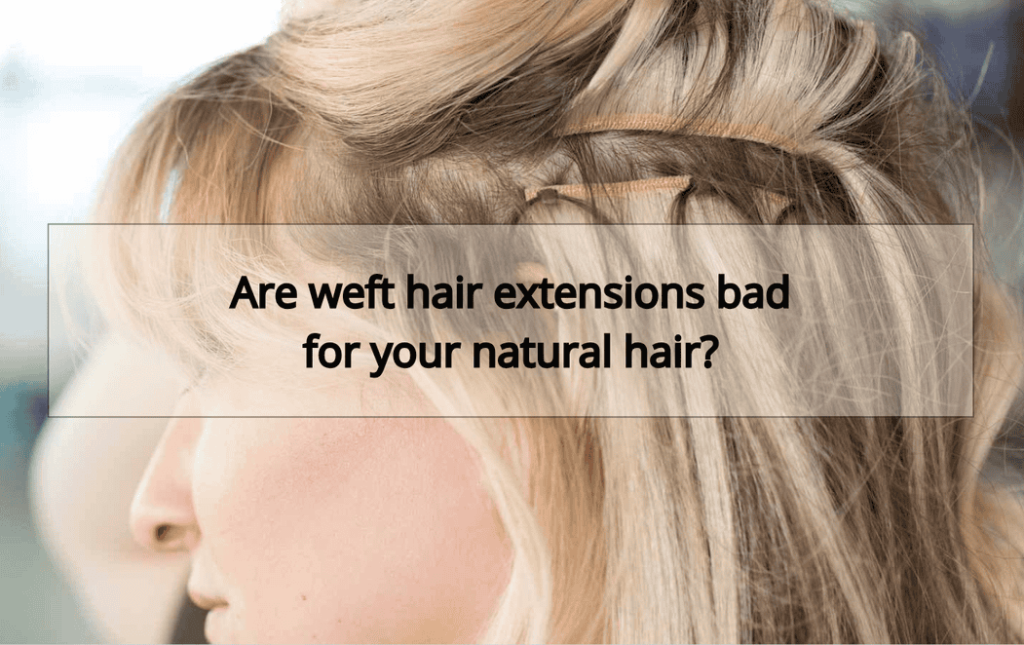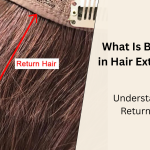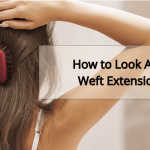Hair Care Tips
Are Weft Extensions Damage Your Hair?
Weft hair extensions have long been a popular choice among salons and clients alike for their volume, durability, and seamless finish. But with every installation method comes a question many hair professionals still ask: “Are weft extensions damaging to natural hair?” In this guide, we’ll explore the science behind wefts, identify potential risks, and share expert-backed strategies to minimize damage—ensuring both client satisfaction and hair health.
I. What Are Weft Hair Extensions?
Weft hair extensions are bundles of hair strands sewn or bonded together at the top, forming a “track” (weft) that can be attached to natural hair through various methods. The three most common types are:
- Machine Weft: Created with a sewing machine, thick and durable
- Hand-Tied Weft: Thinner, more flexible, ideal for fine hair
- Genius/Hybrid Weft: Combines thinness of hand-tied with the cutting flexibility of machine wefts
These wefts are applied using sewing (braid-and-sew method), microbeads, or adhesive-based techniques.
II. Is Weft Damaging to Hair? The Short Answer
Wefts are not inherently damaging, but how they are installed, worn, and maintained determines whether or not they cause harm to natural hair.
Poor technique, excessive tension, or lack of aftercare can lead to issues such as:
- Hair breakage at the root
- Traction alopecia (hair loss due to pulling)
- Tangled weft base or matting
When done professionally and cared for correctly, wefts can be worn safely for months.
III. What Factors Can Cause Damage with Wefts?
While weft hair extensions offer volume and longevity, they must be handled with technical care. When clients experience breakage, scalp sensitivity, or traction-related thinning, the root cause often lies in one of the following four areas: installation tension, hair type mismatch, weight distribution, and improper aftercare. Let’s explore each of these in depth.
1. Installation Tension: Too Tight = Too Risky
Excessive tension is the most common reason wefts cause damage. Whether you’re using the traditional braid-and-sew method or microbead-based installations, applying the wefts too tightly pulls on the scalp and weakens the follicles over time. This can lead to traction alopecia, especially around the hairline and crown.
💡 Pro Tip: A small amount of slack at the root ensures flexibility and comfort. The track should lie flat and secure but never feel painfully tight. If a client feels soreness more than 48 hours after installation, it’s likely too tight.
2. Incompatible Hair Type: Not Every Hair Can Handle a Weft
Not all clients are candidates for weft extensions. Installing heavy machine wefts on someone with fine, fragile, or thinning hair places too much stress on the natural strands, causing shedding or breakage at the root. This mistake is especially common when stylists apply a “one-size-fits-all” approach.
✅ Best Practice: For clients with thin or delicate hair, opt for hand-tied or genius wefts. These options are lighter, lay flatter against the scalp, and blend more naturally—reducing tension and bulk.
3. Uneven Weight Distribution: The Hidden Culprit
Damage doesn’t always happen immediately—it builds up when the weight of the extension isn’t distributed evenly. For example, sewing a long or thick weft into one narrow section causes stress where the natural hair can’t support it. Over time, this leads to tension points, thinning spots, and even bald patches.
🎯 Solution: Always spread the wefts across multiple secure sections. Wefts should match the client’s hair density—not overload it. A quick density check before installation goes a long way.
4. Improper Aftercare: Good Install, Bad Follow-Through
You can do a perfect install—but if the client doesn’t maintain their wefts properly, the damage can creep in fast. Wefts are prone to tangling near the base if left unbrushed or washed incorrectly. Using heavy oils, sulfate-based shampoos, or sleeping with wet hair can all degrade the weft and pull on the roots.
🧴 Education is key: Every weft client should go home with written care instructions. Brush daily with a loop brush, avoid applying conditioners near the weft seam, and return for maintenance every 6–8 weeks. This minimizes tangling, matting, and scalp irritation.
Summary:
| Risk Factor | Problem Caused | How to Prevent |
|---|---|---|
| Too-tight installation | Traction alopecia, scalp pain | Leave room at root, avoid excessive tension |
| Wrong hair type | Breakage, thinning | Choose lighter wefts for fine hair |
| Uneven weight | Localized shedding, tension | Distribute weft across wider areas |
| Poor aftercare | Matting, root stress | Educate clients, regular maintenance |
📌 Weft extensions aren’t damaging by default. The damage stems from poor technique, unsuitable weft choice, and inadequate care. As a professional, your job isn’t just to install wefts—it’s to make sure they’re safe, suitable, and sustainable for your client’s hair type.
IV. How to Prevent Damage When Using Wefts
Installing weft extensions can be a game-changer for your salon clients—if done right. But professional results don’t just come from good product. They come from the right technique, the right match, and the right care. Here’s a detailed breakdown of how to ensure that wefts enhance the hair—not harm it.
1. Choose the Right Weft for the Client’s Hair Type
Every client’s hair is different, and so should be your weft recommendation. Choosing the wrong weft is one of the most common causes of tension, poor blending, and breakage.
- Hand-Tied Wefts: Thin, lightweight, and flexible. Ideal for clients with fine or low-density hair. They lie flat against the scalp and blend invisibly when installed correctly.
- Machine Wefts: Thicker and more durable. Best for clients with medium to thick hair who want full volume.
- Genius Wefts: The hybrid choice. As flat as hand-tied but can be cut like machine wefts without unraveling. Great for clients who want natural movement with more versatility.
✅ Pro Tip: Always match the weft’s weight and thickness to the client’s hair density. Never overload fine hair with a heavy track.
2. Use Proper Sectioning and Tension During Installation
Weft damage often starts with poor application. Whether you’re sewing in tracks or using micro rings, tension control and clean sectioning are key.
- Do not pull too tight. The braid or anchor track should sit flat but not strain the scalp.
- Spacing matters. Avoid placing wefts too close to the hairline or crown unless using ultra-flat wefts like hand-tied or genius types.
- Angle the weft naturally. Follow the direction of natural hair growth to reduce stress on roots.
🎯 Reminder: A tight install may look neat—but if it’s uncomfortable after 24 hours, it’s too tight.
3. Educate Your Client on Proper Aftercare
A flawless install can still go wrong if the client doesn’t know how to take care of it. That’s why aftercare education is part of the service—not optional.
Key aftercare guidelines:
- Brushing: Use a loop or extension brush. Start from the ends and work upward, gently detangling without pulling near the weft seam.
- Washing: Recommend sulfate-free, lightweight shampoos. Clients should cleanse gently, without scrubbing or pulling on the scalp.
- Drying: Never sleep with wet hair. Towel-blot gently, and blow-dry the weft roots to prevent moisture buildup.
- Products: Avoid oils, conditioners, or serums near the track. These can loosen the adhesive or cause slippage if rings are used.
💬 Bonus Tip: Provide a printed or digital aftercare card with every installation. It builds trust and reduces problems between appointments.
4. Book Regular Maintenance Appointments
Wefts aren’t set-it-and-forget-it. Maintenance is non-negotiable.
- Every 6–8 weeks, wefts should be repositioned or reinstalled to account for natural hair growth and avoid tension.
- Check the scalp and braid base for buildup, irritation, or thinning.
- Trim and re-blend extensions to keep the cut seamless and the weight balanced.
🛠️ Why it matters: Neglecting maintenance is a fast track to matting, breakage, or painful pressure points at the weft base.
5. Use Quality Tools and Supplies
Lastly, your technique is only as good as your tools. Invest in medical-grade thread, extension-safe beads, non-damaging clips, and lightweight bonding adhesives if applicable. Avoid cheap supplies—they compromise both performance and hair health.
Conclusion: Are Wefts Worth It?
When used appropriately, weft extensions are not damaging—they’re one of the most versatile and long-lasting extension options available. The key lies in:
- Matching the right weft to the client
- Skilled installation
- Consistent care and maintenance
For salon professionals, choosing a high-quality weft supplier and staying updated with modern techniques ensures happy clients and beautiful results.





